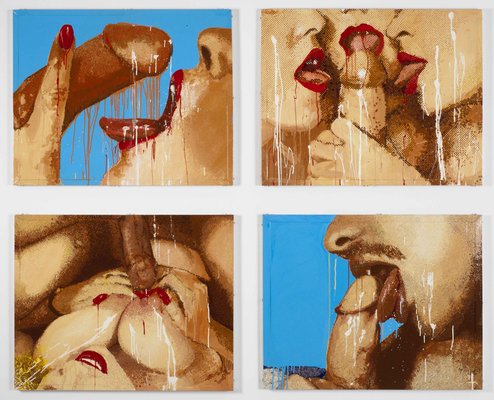Here’s my Time Out New York interview with artist Marilyn Minter — meeting her, visiting her studio, and talking about her work restored my faith in painting (no small feat)! Enjoy!
From her 1969 series of black-and-white photographs showing her own drug-addled mother lying about the house in negligees and curlers, to her recent Times Square billboards of dirt-encrusted feet in fancy high heels, Marilyn Minter has evoked the beauty of imperfection, becoming, in the process, an art-world rock star. But success was a long time coming. In the late 1980s she created a group of paintings based on hard-core pornographic photos, including money shots. Titled “Porn Grids,” these works were slammed as sexist by politically-correct critics , who assumed they spoke for all women. More than two decades on, Minter’s once-soiled reputation has been rehabilitated, and her sumptuous large-scale canvases—of female mouths in lurid close-up, slathered in lipstick, dripping sweat and spitting up pearls—have propelled her to well-deserved fame. On the occasion of a show at Soho’s Team Gallery, featuring those controversial works from the ’80s, Minter looks back at the period and shares her feelings about it.
What was the genesis of the “Porn Grid” series?
The idea came to me after seeing a Mike Kelley show in 1988 at Metro Pictures, which I thought was brilliant. He’d made stuffed animal sculptures, felt banners and decoupaged furniture with magazine cutouts of eyes and lips. And I thought if a woman artist had made this work, it would’ve been dismissed as sentimentality, and not given much attention. It got me wondering, What subject had women artists never touched? And what came to me was porn, but it couldn’t be soft-core—that had been done. It had to be hard-core, complete with money shots. Would the fact that a woman had painted them change the meaning of such images? I was asking questions I didn’t have answers for, and that was my undoing in those politically correct times.
I can’t help thinking that if a male artist like Richard Prince had made similar images back then, they would have cemented his reputation. Why do you think the reception you got was so different? Was it sexism?
People simply weren’t used to prosex feminists or women owning sexual imagery, so the press was pretty bad. And it was a blanket rejection by male and female critics alike. I’d actually thought that those on the left would have been my ally, regardless of gender. I mean, nobody has politically correct fantasies, right? Anyway, I was inconsolable at the time, and decided that if they didn’t like my work I was going to make images that were even nastier—an immature reaction on my part, I guess, because I believe artists should try to communicate, not chase people out of the room.
What were some of the criticisms that hurt the most?
Being on the losing end of a comparison with Cindy Sherman, who is a hero of mine. That was probably the worst. Also, if you work with sexual imagery and it’s rejected, it just feels like an endless wave of shame.
Why is pornography so taboo for female artists?
There’s just this glass ceiling when it comes to women working with sexual imagery. Look at Laurel Nakadate, a really great, interesting artist. She’s making a picture of a reality that exists, and it’s never been documented by anyone, male or female. Hers is a fresh vision, and her critics dismiss it as exploitation!
I think objectification occurs whether the body is idealized or denigrated. What makes the “Porn Grid” series so relevant today is the way it rides the line between the two, refusing to adhere to an either/or position.
Telling people what to think is not interesting to me. Art is supposed to transcend the binary terms of language.
Speaking of binaries, the Team Gallery show also includes another ’80s series of yours, “Big Girls/Little Girls,” which depicts young girls in the 1950s looking into fun-house mirrors. Those were actually well received as a commentary on the cultural prescriptions of beauty. Was that what you were aiming for?
Maybe. Intentions aren’t something I think about; it’s all subliminal for me. I did get an article in Arts Magazine about that work, but it was unreadable. I had no idea what the writer was saying, and I must have read it ten times!
Marilyn Minter, “Paintings from the ’80s” is on view at Team Gallery, through Apr 30.


